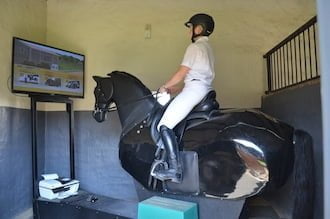Fans of dressage who follow social media may recently have heard word circulating about Travis the dressage simulator. When HQ learned about the ‘robot horse’ that can teach you to ride, we had to try it for ourselves.

Accurate simulation
Instruction on the Racewood Dressage Simulator is offered by Charmaine Gardner of CHG Equestrian, based at Equestria in Kyalami. The unit mimics the shape and movement of a real horse, with sensors in seat, rein and leg positions to provide data on rider aids. Each sensor is also programmed to respond to weight and pressure as a Grand Prix horse would respond to correctly applied aids.
Get with the progamme
Travis can be ridden in various modalities, the first of which provides an initial analysis to identify your trouble spots. Once complete you ride through a supervised instructional session. During the session rider information can be viewed onscreen with graphs providing real-time feedback from the sensors.
Imbalancing act
 Riding in my own saddle to best replicate my work at home, it quickly became apparent that I have a misaligned pelvis. My left stirrup was a hole longer than my right and the padding in my saddle was about a centimetre flatter on the right-hand side. This has certainly had an impact on the straightness of my horse. Other areas of concern: rigid hands and an inflexible contact, too much leg and a tendency to pitch forward; I don’t truly know the aids to canter, or make a downward transition. My halt aid brought us to a standstill in one stride.
Riding in my own saddle to best replicate my work at home, it quickly became apparent that I have a misaligned pelvis. My left stirrup was a hole longer than my right and the padding in my saddle was about a centimetre flatter on the right-hand side. This has certainly had an impact on the straightness of my horse. Other areas of concern: rigid hands and an inflexible contact, too much leg and a tendency to pitch forward; I don’t truly know the aids to canter, or make a downward transition. My halt aid brought us to a standstill in one stride.
In addition to pinpointing problems, the simulator is capable of high-level movements, such as piaffe, passage, half pass and pirouettes.
Mood swings
Although not strictly included in the programme, the simulator provides some eye-opening input in terms of the influence of your mood on your ride. Horses can definitely feel your stress, which will usually translate to unyielding contact, an inflexible back, rigid hips and harsh leg aids.
The perfect horse?
Like any horse, Travis isn’t perfect. His gaits feel a little too smooth and he lacks the elastic swing I love in a moving horse. Aside from his maddening refusal to respond to my terrible aids, he offers no real feedback. He doesn’t smell like horse and he thuds when you pat him (which you will do out of habit). But it’s a small price to pay for the experience to be gained.
Since riding the simulator my seat is quieter and my aids more precise. A canter depart is a smooth move from a ‘two-three’ leg position … I can do it from a walk. And every day I offer my mare a quiet kiss for not ditching me when she really deserved to.
See it in action:
Text: Brigitte Billings
Photography: Charlotte Bastiaanse
The full issue appears in the April issue (98) of HQ.

